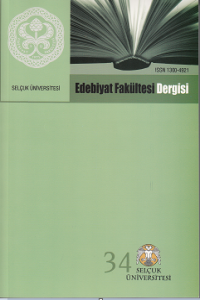THE IMAGE OF THE BULLFIGHT AND BULLFIGHTER IN 20TH CENTURY SPANISH POETRY: LORCA'S ELEGY LAMENT FOR IGNACIO SÁNCHEZ MEJIAS / 20. YÜZYIL İSPANYOL ŞİİRİNDE BOĞA GÜREŞİ VE MATADOR İMGESİ: LORCA'NIN IGNACIO SÁNCHEZ MEJIAS'A AĞIT ÖRNEĞİ
Abstract
The Spanish people worship bulls with the characteristics like aggressiveness, power and fearlessness, and also worship the bullfighters that fight a dual with bulls. The tradition of bullfight defines the basic character of a nation which perceive life as becoming continuously face to face with death. This character makes the Spaniards consider bullfights as a form of art and the possibility of death becomes an inspiration of this deadly art. The famous Spanish poet Federico García Lorca calls as duende, the muse that comes up at the time when the bullfighter come face to face with death. In this study it's aimed to indicate the roots of the Spaniard's affection for bullfighting. As in 20th century Spanish poetry bullfights theme and image of death is cultivated rather frequently, we'll take Lorca's poem Lament for Ignacio Sánchez Mejías as the study object and we'll intend to analyze this elegy in the aspects of Ignacio's bullfighter figure, the expression of death and mourning and also the symbolical images drawn by Lorca.
References
- BENITO LOBO, José Antonio (2000). Literatura para la vida, Madrid: Edinumen.
- BOADO, Emilia - CEBOLLA, Fermin (1976). Las señoritastoreras, Madrid: Felmar.
- CLARAMUNT LÓPEZ, Fernando (2011). Antología de Escritos Taurinos, Vol.1, Valencia, 2011.
- CORROCHANO, Gregorio (1969). “De como se debenver las corridas de toros”, Los Torosen España, Tomo 1, Dir. Carlos Orrellana, Madrid: Editorial Orel.
- DELGADO RUIZ, Manuel (1986). De la muerte de undios, Barcelona: Nexos.
- DOMINIQUE, Lapierre - Collins, Larry (1993). YasımıTutacaksın, İstanbul: Payel.
- FREUD, Sigmund (1917). "Mourning and Melancholia", The Standard Edition of the Complete Psychologica Works of Sigmund Freud, Volume XIV.
- GARCIA LORCA, Federico (1942). "Teoría y juego del duende", Obras Completas, 7, Buenos Aires: Losada.
- GARCÍA LORCA, Federico. ''Lament for Ignacio Sánchez Mejíllas'', (Traduced by A.S.Kline), http://www.poetryintranslation.com/PITBR/Spanish/FiveintheafternoonLorc a.htm(25.10.2015).
- HONIG, Edwin (1941). ''The Poetry of Federico García Lorca'', New Mexico Quarterly Review, No: 4, November, Volume XI, pp. 389-413.
- LÓPEZ IZQUIERDO, Francisco (1972). Torosen Segovia, Segovia: Publicaciones de la Cajade Ahorros de Segovia.
- MARÍA DE COSSIO, Jose (2007). Los Toros: Literatura y periodismo, 8, Madrid: Edelsa. MONTES “PAQUIRO”, Francisco (1969).“De Arte de torear”, Los TorosenEspaña, Tomo 1, Dir. Carlos Orellana, Madrid: Editorial Orel.
- ORR, Gregory (2002). Poetry as Survival, Athens: University of Georgia Press.
- RÍOS RUIZ, Manuel (1990). Aproximación a la Tauromaquía, Madrid: Istmo.
- SACKS, Peter (1985). The English Elegy: Studies in the Genre from Spenser to Yeats, Baltimore: Johns Hopkins University Press.
- TORO BUIZA, Luis (1947). Sevillaenla historia del toreo, Sevilla: Ayuntamiento de Sevilla.
- TORO BUIZA, Luis (1969). “Posiblesorígenes del arte del toreo”, Los TorosenEspaña, Tomo 1, Dir. Carlos Orellana, Madrid: Editorial Ore.
- TRUJILLO, Jose Antonio (1981). Los torosen la literatura, A. Santiago Orozco, lidiadoren las ondas y maestro de la críticataurina, Madrid: Impreso de España.
- YENER GÖKŞENLİ, Ebru (2011). İç Savaş Sonrası İspanyol Romanına Yansıyan Tarihsel, Toplumsal ve Sosyal Çeşitliliğin İncelenmesi, (Analysis of thehistorical and social variety reflected on the Spanish Post-War Novel), Istanbul: University of Istanbul, Institute of Social Sciences, (Published PHD Thesis).
Details
| Primary Language | English |
|---|---|
| Authors | |
| Publication Date | December 30, 2015 |
| Submission Date | February 13, 2016 |
| Published in Issue | Year 2015 Issue: 34 |
Cite
Selcuk University Journal of Faculty of Letters will start accepting articles for 2025 issues on Dergipark as of September 15, 2024.

